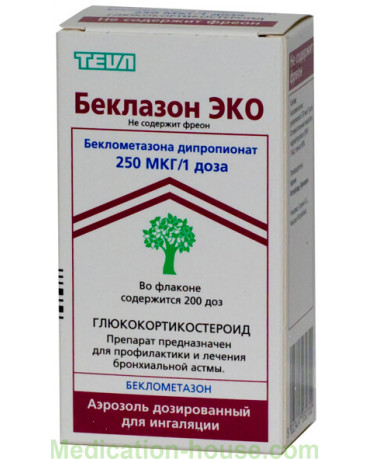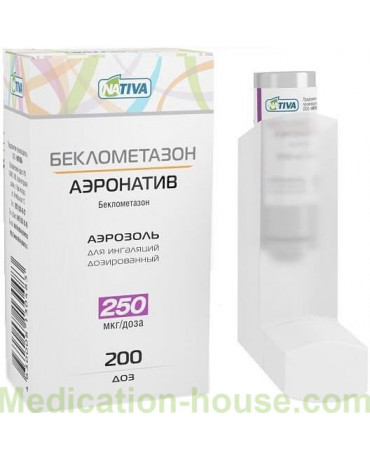Release form and composition
The active substance is beclomethasone dipropionate.
Available in the form of an aerosol for metered-dose inhalation (200 doses in aluminum aerosol cans with a spray system, 1 spray can in a cardboard box).
The active substance content in 1 dose is 50 mcg or 250 mcg.
Pharmacodynamics
Beclomethasone belongs to glucocorticosteroids and has a weak tropism for corticosteroids receptors. With the participation of enzymes, it turns into an active metabolite - beclomethasone-17-monopropionate (B-17-MP), which is characterized by a distinct local anti-inflammatory effect. Beclomethasone reduces the intensity of the inflammatory process by suppressing the formation of the chemotaxis substance (effect on late allergic reactions), slows down the development of immediate allergic reactions that are caused by inhibition of the synthesis of arachidonic acid metabolites and a decrease in the release of inflammatory mediators from mast cells, and also stimulates the processes of mucociliary transport.
The drug provides a decrease in the number of mast cells in the mucous membrane of the bronchi, suppression of mucus secretion by the bronchial glands, decrease in swelling of the epithelium, bronchial hyperreactivity, marginal accumulation of neutrophils, and also inhibits the production of lymphokines and inflammatory exudate, slows down the migration of macrophages and helps reduce the intensity of granulation and infiltration processes.
Thanks to beclomethasone, the number of active beta-adrenoreceptors increases, the patient's reaction to bronchodilators is restored, which reduces the frequency of their use. After inhalation, the substance has practically no resorptive effect.
The drug lacks the ability to stop bronchospasm, and the therapeutic effect develops gradually with maximum severity, usually 5-7 days after the start of therapy.
Pharmacokinetics
More than 25% of beclomethasone, administered as an inhalation, settles in the respiratory tract, and the remaining amount settles in the pharynx and oral cavity and is swallowed. In the lungs, before the start of absorption, the compound is actively metabolized, forming the active metabolite B-17-MP. Systemic absorption of the latter is carried out in the lungs (up to 36% of the pulmonary fraction of the substance) and the gastrointestinal tract (up to 26% of the amount received here when swallowed). The absolute bioavailability of beclomethasone unchanged and B-17-MP is respectively approximately 2% and 62% of the dose received by the body in the form of inhalation.
Beclomethasone is absorbed at a high rate, and the maximum concentration of a substance in blood plasma is reached in 0.3 hours. B-17-MP is absorbed more slowly. The time to reach the maximum concentration of this metabolite is about 1 hour. An approximate linear relationship was found between an increase in the dose administered as an inhalation and a systemic exposure of the active component of the drug.
For beclomethasone, the distribution in the tissues is 20 liters, and for B-17-MP, 424 liters. The drug binds fairly well (87%) with plasma proteins.
Beclomethasone and B-17-MP are characterized by a high plasma clearance of 150 l / h and 120 l / h, respectively. The half-life is 0.5 hours and 2.7 hours, respectively.
Indications for use
The action of the drug is aimed at reducing edema of the epithelium, mucus secretion by the bronchial glands, edge accumulation of neutrophils, bronchial hyperreactivity, inflammatory exudate (fluid at the site of inflammation).
According to the instructions, beclomethasone is prescribed in the following cases:
Bronchial asthma (inhalation use);
Prevention and treatment of allergic rhinitis, including vasomotor and rhinitis with hay fever (intranasal use);
Infectious and inflammatory diseases of the ear and skin (external and local) - in combination with antimicrobial agents.
Contraindications
Bronchitis of non-asthmatic nature, acute bronchospasm;
Frequent nosebleeds, hemorrhagic diathesis;
Systemic infections, including pulmonary tuberculosis, acute respiratory infections, herpes eye damage.
Beclomethasone aerosol is contraindicated in children under 6 years of age and women in the first trimester of pregnancy.
Instructions for use: method and dosage
Inhalation application:
Adults - 500 mcg 2 times a day or 250 mcg 4 times a day, the daily dose should not exceed 1000 mcg (2000 mcg is allowed only in very severe cases, while the daily dose is divided into 4 doses);
Children from 6 years old - 50-100 mcg from 2 to 4 times a day.
Intranasal administration:
Adults and children over 12 years of age - 100 mcg 3-4 times a day in each nasal passage, not exceeding a daily dose of 1000 mcg;
Children 6-12 years old - 50 mcg in each nasal passage (no more than 500 mcg per day) with the same frequency of doses as adults.
A more accurate dosage regimen and duration of treatment is determined by the doctor.
Side effects
Beclomethasone aerosol can cause unwanted reactions of the body, in particular, such as:
Sneezing, coughing, sore throat, dysphonia, rarely - paradoxical bronchospasm (eliminated by inhalation bronchodilators), eosinophilic pneumonia;
Candidomycosis of the upper respiratory tract and oral cavity;
Dizziness, headaches, increased intraocular pressure, cataracts, lymphopenia, eosinopenia, leukocytosis - with prolonged use in large doses;
Epistaxis, rhinitis, perforation of the nasal septum, atrophy of the mucous membrane - with intranasal use;
Dysfunction of the hypothalamic-pituitary-adrenal system - with a single use of more than 1000 μg beclomethasone dipropionate;
Allergic reactions.
Overdose
Symptoms of acute overdose may develop with a single high-dose inhalation of more than 1 g. In this case, signs of inhibition of adrenal cortex function are most often manifested, and there is no need for emergency therapy. This is due to the restoration of this function over several days, which is confirmed by a change in the level of cortisol in blood plasma.
In chronic overdose (prolonged treatment with doses of more than 1.5 g), persistent suppression of adrenal cortex function can be observed. In such a situation, the reserve function of the adrenal cortex should be regularly monitored. In case of an overdose, the course of treatment with beclomethasone can be continued provided that sufficient doses are administered to maintain the therapeutic effect.
special instructions
For women in the II and III trimesters of pregnancy, as well as nursing mothers, the advisability of using beclomethasone is determined by the doctor. If you take the drug during lactation, breastfeeding should be discontinued.
Caution is required for intranasal use of the spray by individuals with nasal septal symptoms, glaucoma, amoebiasis, hypothyroidism, and severe renal failure.
Recently suffered myocardial infarction, performed in the recent past, operations of the nasal cavity and nasal trauma are a reason for limiting the use of beclomethasone.
Influence on the ability to drive vehicles and complex mechanisms
Beclomethasone inhalation does not significantly affect the ability to drive vehicles or engage in potentially hazardous activities that require an increased reaction rate and serious concentration.
Pregnancy and lactation
The drug during pregnancy and during breastfeeding is used with extreme caution, only if the expected benefits to the mother exceed the possible risks to the fetus and baby.
Newborns whose mothers were treated with beclomethasone during pregnancy should be carefully examined to identify adrenal insufficiency.
Use in childhood
Children under 6 years old are not assigned.
The drug, in 1 dose of which contains 250 μg beclomethasone, is not intended for children under 18 years of age. With inhalation, a single dose for children is 50-100 mcg, and the frequency of use does not exceed 2-4 times a day.
Drug interaction
Beclomethasone restores the patient's response to beta-adrenergic agonists, which significantly reduces the frequency of their use.
When the drug is combined with rifampicin, phenytoin, phenobarbital and other inducers of microsomal liver enzymes, the therapeutic effect of the use of beclomethasone becomes weaker.
The simultaneous use of beclomethasone with theophylline, methanedienone, beta2-adrenergic agonists, estrogens, as well as systemic glucocorticosteroids helps to increase the effectiveness of beclomethasone.
With the combined use of beclomethasone and beta-adrenergic agonists, the effect of the latter on the body is enhanced.
In especially sensitive patients, beclomethasone may interact with metronidazole and disulfiram due to the content of ethyl alcohol in the preparation.
Terms and conditions of storage
Store at a temperature not exceeding 30 ° C.
Shelf life - 3 years, after opening the spray, the contents should be used within 6 months.
Reviews
According to reviews, beclomethasone in most cases helps to quickly alleviate the patient's condition. There are reports of unpleasant side effects, but in general, doctors and patients consider it an effective drug.
Terms of sell
You can buy Beclomethasone without a prescription from a doctor.



